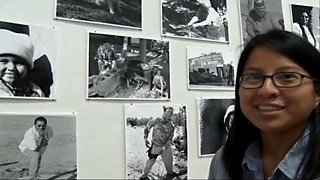Breaking a 'Fever'
New filmmakers hope to shed light on Navajo Nation's paradox of plenty
By Matthew Irwin, Fri., Sept. 6, 2013
An outbreak of yellow fever has been infecting the Southwestern United States since World War II, but you probably haven't heard about it yet, because it helped win the war and it powers many of our homes. We're talking about the yellow glow of uranium ore and its devastation of the Navajo Nation.
In the film Yellow Fever, viewers visit the Four Corners area of Utah, Colorado, New Mexico, and Arizona, where the Navajo people are fighting against uranium development and living with its consequences. But there's also a more familiar backstory surrounding the film: Its creators moved to Austin with the hope of turning their DIY venture into lifelong careers through collaboration and bill-paying industry work.
"It was definitely, at times, a labor of love," says Sophie Rousmaniere, one-half of the media company Issue TV with her husband Jay Minton. "Luckily, we've been able to get enough funding to invite experts when we needed them, but most of the time it was Jay and I."
Screening at Pine Street Station on the Eastside this week, Yellow Fever focuses on the exploitation of uranium deposits throughout the Navajo Nation. First, the unstable mineral was mined for nuclear bombs for World War II; now, energy companies want it for nuclear power. At the center of the film, Navajo Tina Garnanez has returned to her homeland after two tours of duty with the U.S. Army that left her with PTSD. While photographing her people to help her heal, she uncovers the story of her own family's loss due to radiation associated with uranium mining. By her count, a total of 11 family members have died from cancer.
Rousmaniere had been working on a film about the effort to prevent a coal-fired power plant, when her research led her to the uranium legacy and Garnanez. After an initial grant from New Visions/New Mexico launched the project in 2008, a second boost came from the Corporation for Public Broadcasting in 2012. Rousmaniere and Minton had been living in Santa Fe all this time, talking about a relocation to Austin; however, the film and a pregnancy kept them in Northern New Mexico until the summer of 2012. They did a lot of the editing in Austin, where Tom Parish did the color correction and musician Guy Forsyth provided some music, in addition to the textural tunes recorded by Minton on mandolin and Navajo cellist Randall Warren, also a New Mexico transplant. In the coming months, Rousmaniere and Minton would buy a house, raise $21,000 for their next film on Kickstarter, and travel to Cameroon to begin shooting that film, while also submitting Yellow Fever to film festivals and booking a tour of the Southwest.
"As an independent filmmaker, I shoot, I edit, I write grants, I produce. Luckily, I don't do sound anymore," Rousmaniere says, calling from the road. "There are many aspects of creating a good film, and sometimes, if you try to do it all yourself, it loses something."
In truth, Yellow Fever is still guilty of losing something: focus. In addition to a few minor editing burps, the film holds too tightly to a number of peripheral historical events and the ephemera of Garnanez's life. Not that a massive spill of nuclear material at Church Rock, N.M., in 1979 is unrelated or even uninteresting, for instance, but we spend too much time at an event memorializing the disaster rather than understanding its significance. Likewise, we follow Garnanez to an event celebrating American-Indian veterans that produces one really great line, but otherwise takes us off track. Finally, after the filmmakers explore the other side of the argument – the notion that uranium mining is necessary to meet increasing energy demands – the narrative becomes a scattershot of supporting interviews and facts that we never really come back from.
The film's redemption, however, comes from material that both illuminates the issue at hand and exposes the continued exploitation of American-Indians in the name of progress. According to the film, the Navajo Nation sits on one of the biggest uranium deposits in the world. Meanwhile, the Navajo people live in a veritable third world, without running water and without political power. This dichotomy between an area rich in natural resources and the local inhabitants' inability to create wealth from those resources is called a "paradox of plenty." Add that to the log of atrocities committed by the U.S. against its native peoples, and consider, too, the culture's inability to move forward or backward.
"It's hard to understand the concept of assimilation and autonomy," says Rousmaniere. "They live in a window between old ways and new ways. And living in cities, we may have a sense of loss with the state of the planet, but, here, it's cultural, embedded with the land and each other."
Yellow Fever screens Saturday, Sept. 7, 7:30pm, at the Pine Street Station (1101 E. Fifth). Visit www.yellowfeverfilm.com for more information on the project.











